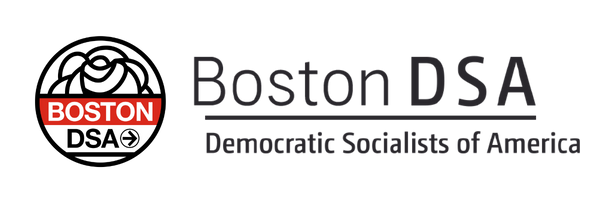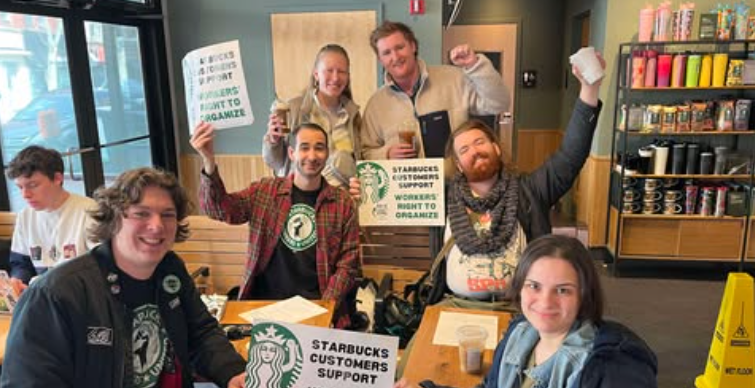[[{“value”:”
By Terence Cawley
SOMERVILLE, MA — As Starbucks Workers United continues to organize for respect on the job, workers have begun escalating pressure on the company locally and across the country.
Since 2021, over 550 stores representing over 10,500 workers have unionized – more than 25 percent of which have joined since February 2024. None have reached a collective bargaining agreement with management. Starbucks Workers United’s demands include a company-wide living wage, expanded healthcare benefits and paid leave, and consistent scheduling. The union is also fighting for protections from racial and sexual harassment and enshrinement of current benefits in the contract itself.
“My coworkers and I who supported and voted yes on Election Day wanted more of a voice in how our workplaces were run and what impacts it had on us,” said Julie Langevin, who joined Starbucks Workers United as a staff organizer for the Northeast after becoming involved with the union as a rank-and-file Starbucks barista in the winter after its formation. “For us to be factored into the equation at all.”
From 2021 to 2024, Starbucks pursued an aggressive anti-union strategy. Workers responded in kind with over 700 Unfair Labor Practice (ULP) filings with the national Board. The company appeared to change course in February 2024 when management reached an agreement with Starbucks Workers United to negotiate a “foundational framework” for contracts for union stores before failing to meet its own end-of-year deadline. The company offered no raises or benefit increases for union baristas in the first year of their contracts, a clear violation of the union’s demands, which Starbucks Workers United rejected by going on strike at 300 stores on Christmas Eve 2024 in the largest labor action in company history.
Starbucks CEO Brian Niccol earned over $97 million in 2024 while commuting from his California home to company headquarters in Seattle via private jet.
From Filings to Sip-ins to Strikes
Starbucks workers in Seabrook, N.H. filed a petition in February for a union election with the National Labor Relations Board. The election is scheduled for April 3, 2025. Should workers vote to unionize, their shop will become the fourth Starbucks in New Hampshire to unionize.
But filings have become only the beginning of a larger pressure campaign. Starbucks Workers United escalated further in March as negotiations stalled: from March 8-11, Starbucks Workers United members and allies hosted “solidarity sip-ins” at over 100 Starbucks locations in advance of the company’s annual shareholder meeting on March 12. Supporters ordered coffee under names like “union strong” and unionists held strategic organizing conversations about the union with non-union baristas. Starbucks Workers United has employed sip-ins to recruit baristas at not-yet-union stores, offer moral support at union stores, and apply public pressure on Starbucks in a way that unites workers and union supporters.
“This round of sip-ins was specifically [meant] to show the holes in the company’s ‘everything’s fine here’ messaging that they put out around their shareholder meeting,” said Langevin. “Knowing we’re seen and supported is so very valuable and breaks down the isolation and doubts we have while organizing.”
On the last day of the nationwide sip-ins and the day before the national shareholder meeting, Starbucks workers in three cities went on strike and occupied their shops to demand fair union contracts. The company called police on workers in all three cities to arrest protesters. Langevin believes the entire gamut of tactics were effective in applying pressure on the company:
“Not only did we see a decline in Starbucks stock in real time as our sip-ins and strikes and acts of civil disobedience were publicized around the country, but we’ve heard reports from managers and seen heightened presence from low and mid-level leadership in stores terrified that we’ll keep escalating and growing.”
On the Frontline of a Local Sip-in
Enthusiasm for the union was high at one local solidarity sip-in held at a Starbucks store in Davis Square in Somerville. Two baristas verbally thanked supporters for their work.
One sip-in attendee, Brian Murray, was a “salt” organizing on the inside as a rank-and-file worker during the initial wave of Starbucks organizing in 2021. After two years with Starbucks Workers United, he now works for the Harvard Graduate Student Union, HGSU-UAW Local 5118. Murray noticed that when he got to the register to order, the cashier was taken off duty and someone who appeared to be a manager took their place.
“This was a tactic I saw in Buffalo,” Murray said. “Often, corporate wouldn’t want everyday workers to receive that support and have those interactions.”
Still, Murray found it “really heartening” to see his fellow community members show up to support Starbucks workers. Support can bleed across industries and strengthen morale across multiple kinds of workers in different shops. In Buffalo, striking nurses showed up at Starbucks shops during their pickets to encourage Murray and his coworkers.
“For some folks, that was really empowering,” said Murray. “Gave them strength.”
What’s next for Starbucks Workers United?
Supporters of Starbucks Workers United can show their solidarity and receive email updates about future actions by signing the No Contract, No Coffee pledge. Langevin also confirmed workers will continue to escalate in its fight with Starbucks for the strong union contracts its members deserve.
“As of right now, our goal is to get Starbucks back to the bargaining table,” said Langevin. “[As] our acts of civil disobedience show, we’re willing to do whatever it takes to get there.”
Terence Cawley is a member of Boston DSA.
“}]]

